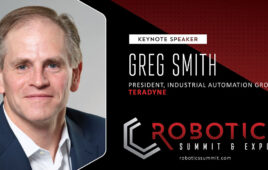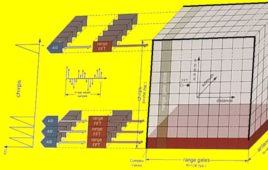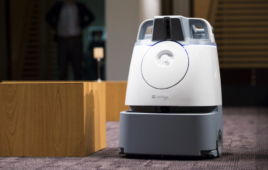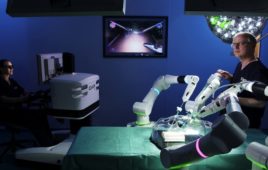
6 River Systems’ Chuck autonomous mobile robots. | Credit: 6 River Systems
Last week, Shopify announced the intent to acquire 6 River Systems, a Boston-based automation firm that provides solutions for e-commerce fulfillment. While the $450M deal is not yet done, this will be the first major acquisition that has happened in this space since Amazon purchased Kiva Systems in 2012.
In the broader collaborative robotics industry, two of the three major acquisitions (the third being Teradyne’s purchase of Universal Robots in 2015) were for autonomous mobile robot (AMR) solution providers. This landmark deal is significant for a number of reasons and is evidence the AMR market is on the verge of exponential growth.
Mobile robotics industry here to stay
The market’s response to AMRs has shifted from skepticism to acceptance to fear of missing out (FOMO) in a relatively short period of time. There is no longer any question as to whether AMRs provide value, or whether they can be safe and play well with humans. Companies like 6 River Systems, Locus Robotics, NextShift, Vecna Robotics and others have provided the answers in real-world deployments.
Not only do they create greater efficiencies and supercharge productivity, AMR-based solutions from several companies have also been warmly accepted by distribution center and warehouse staff despite early worries of job loss due to automation. Easy implementation, simple training, improved workplace safety, and fewer stressful, physically demanding, repetitive tasks are all factors that have led to higher employee morale. Better morale lowers turnover, and in an industry that often experiences turnover of more than 200%, that means lower costs and higher productivity. This allows the company to remain competitive, stay in business, expand, and offer more jobs.
What’s more, these low-cost, easy-to-implement solutions offer low-risk, low-barrier-to-entry options for organizations of all sizes. They act as a workforce multiplier, thus leveling the playing field for small and medium enterprises to compete in the global economy.
Novelty has no sway
Robotics companies can no longer rely on the “novelty play” alone to sell a product. In the 2000s, iRobot rode the novelty wave with great skill. They brilliantly sold the Roomba robotic vacuum at a low enough price that middle-class consumers could purchase them with disposable income. At that price, the novelty of having a robot in the home was a major part of the value proposition. This provided iRobot the runway needed to improve the product to the point where the larger value proposition was that it cleaned floors effectively, and in the process created a whole new market segment.
But the time of the novelty play for the robotics industry is waning. For the average consumer to the shrewdest CEO, robots are no longer “cool” merely because they are new technology – now a rock-solid value proposition is required to make the sale. 6 River Systems created a product with the customer’s ROI – not novelty – in mind. In fact, the robot was not the solution. Rather, it was the:
- Software-driven workflow
- The intelligent application of machines to optimize traditionally-manual processes
- The ability to adapt it to specific organizational needs.
The 6 River Systems team, some of whom worked for Kiva, no doubt knew this from experience. They approached the problem with less enthusiasm for the technology and more focus on solving a real customer pain point.
Fundamentally, 6 River Systems is a solution provider, not a robotics company. This is a critical distinction, and an important lesson for others in the field of automation. Novelty no longer sells. An automation provider must solve problems. Companies like Shopify are taking notes from Amazon’s playbook and realize a solid automation solution is the key to scaling up rapidly and competing in the new economy. This, of course, requires more than cute robots.
Now is the time to invest
A number of investor-backed robotics companies closed up shop within the last few years after raising significant sums (interestingly, none of them were AMR-focused companies). Hence, it is not surprising that robotics investments would be viewed with skepticism. Investors have been wary of engaging with robotics companies for several other reasons too:
- Automation solutions are capital-intensive to develop in terms of materials, equipment and talent
- Hardware is costly to prototype and challenging to scale
- There have been relatively few major successes to date.
Thankfully, Tom Ryden and the great team at MassRobotics have introduced new models to help robotics startups overcome many of these challenges, and investors are learning to love again.
It is important to recognize the distinction between the robotics startups of the last decade that built robots and the solution providers like 6 River Systems that address a clear and specific market need. The saavy investor recognizes these distinctions and is likely to invest accordingly before the broader market catches on.
When we founded MassRobotics, it was specifically with the intent of helping to move the industry from “cool” robots to real-world solutions that provide concrete value. This success is a great example to the hundreds of other robotics startups in the MassRobotics ecosystem, and even to Boston Dynamics, which has recently taken steps (pun intended) to get into the logistics automation game. But don’t worry, it has pledged to continue kicking their robots.
Congratulations to 6 River Systems and the broader mobile robotics industry for this achievement!
Editor’s Note: Are you interested in sharing your thoughts about robotics development with The Robot Report? Submit a guest column today be e-mailing The Robot Report Senior Editor Eugene Demaitre.
About the Authors
Daniel Theobald is CEO of Vecna Robotics and Co-Founder and President of MassRobotics. Theobald also co-founded Vecna, parent company of Vecna Robotics, in 1998. Matthew Cherewka is Solutions Design Manager at Vecna Robotics.
Filed Under: The Robot Report, Robotics • robotic grippers • end effectors





Tell Us What You Think!